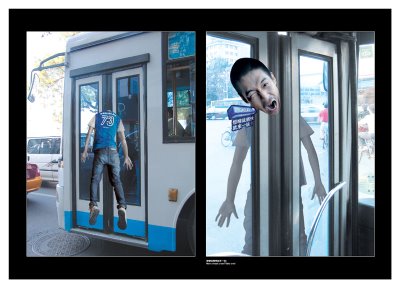|
| AD 205 Introduction to Computer Graphics
Assignment 1:
Photoshop Project: CG Buzz Marketing
Due: Wednesday, September 3
Photoshop tutorial .pdf format
Create an image for conventional marketing project about buzz
marketing. Identity of the product, brand or service to be
promoted and create a digital composition in Photoshop that
generates buzz to gain attention. Use images below and class
examples for inspiration and reference.
Most marketing, advertising, and PR follows a "push"
strategy. No one enjoys marketing that pushes you (pure advocacy).
Buzz marketing, however, is completely different. It captures
attention of consumers and the media to the point where talking
about your brand becomes entertaining, fascinating, and newsworthy.
Word-of-mouth is the oldest, most effective form of marketing
on earth. A very successful word-of-mouth promotion creates
buzz. The result is everyone is talking about or purchase
the product or service. A recent U.S. study found that two-thirds
of all consumer goods sales are now directly influenced by
word-of-mouth. Some big companies are trying to capitalize
on that. When Ford, for instance, was getting ready to launch
the Focus, it recruited trendsetters in a handful of markets,
gave them each a new vehicle and told them simply to be seen
with the car.
Think of what defines your product, brand or service identity,
design, strengths, etc. Traditionally, the power of image
has been used to influence the masses. How will you build
on this idea and capitalize on it? What kind of mission statement
it instills? How do you get people talking about your brand?
How your image can provoke the attention? Work for fun, cleaver,
expressive conceptual content.
Create a composition using many of the Photoshop tools you
know. Your digital composition may contain visual elements
from scanned images, photographs and other collage materials.
Your work should demonstrate your technical proficiency in
Photoshop. Your final composition should show several techniques.
Utilize layers, cutting, copying, and pasting. Develop your
drawing, painting, blending, and layout techniques. Image,
scanned images, textures and text may be combined. Focus on
effective use of color and value. Be aware of the relationship
between the elements of your composition. Your imagery should
reflect your thoughts in execution, as well as content and
you will be graded on those strengths. Be prepared to discuss
the meaning and why you chose the visual elements you did.
Technical requirements:
dimensions: 800 x 600 pixels
resolution: 300 pixels per inch
mode: RGB color
Save file as "1_your last name.psd”.
You can submit Photoshop file for this assignment into the
drop folder for our class on the server:
/classes/_2008_Fall/AD205_Daria/Drop
Examples:
about Buzz marketing from buzzmarketing.com
 


Buzz marketing stands in direct contrast to traditional television
or radio advertising -- the classic 'mass marketing' approach
that is based on the premise of broadcasting a message as
widely as possible, assuming that this is the best way to
reach the largest possible number of interested consumers.
Buzzing, which might also be described as 'micro-marketing,'
assumes that a person-to-person marketing message is much
more powerful because it is so personal -- and that it could
potentially reach more people than a broadcast message, if
only it is buzzed about in great quantity by people who have
very long contact lists and no qualms about promoting products
to anyone who will listen.
Wind points to a survey performed by CNW Marketing Research
on the 15 largest U.S. television markets as evidence of why
buzz marketing is becoming so important to companies today.
It found that more than half of the ads for cars, credit cards
and pet-related products are ignored by television viewers.
In addition, 42% of ads about home products are ignored, as
are 45% of fast food advertisements. The numbers are far worse
in the case of viewers with personal video recorders such
as TiVo. For that group, 95% of fast food ads were skipped,
as were 68% of car ads, 80% of pet product ads, and 94% of
financial product advertisements. "The 30-second commercial
is becoming less and less powerful. We have to realize that
most of the money spent on advertising is being wasted, so
advertisers have to look for others sources and ideas for
marketing their products," Wind says.
That's why Vespa turned to buzz marketers to ride its scooters
around town and talk up their 'cool factor' when they debuted,
and why Ford loaned its new Focus cars out to buzz agents
for the first six months of its launch. In each case, companies
looked for ways to gain high visibility and personal recommendations
through buzz.
Not every product can be effectively marketed by buzz agents,
however. "It has to be an interesting one," says
Kahn. "Products do have to live up to the hype, they
do have to deliver. If these products aren't delivering coolness,
this will not over time be a credible method." According
to Kahn, products that fit this description are fashion items
and items of cultural interest such as TV shows, books and
movies -- anything that connotes a sense of being 'in the
know.' "They have to be products where value comes from
the social interaction," Kahn says. "What you wear,
what movies you go to, what things you read -- these are all
influenced by social opinion. There are other things that
I buy where I don't care what other people think about them.
I like Sweet Tarts. I don't really care what anybody else
thinks about Sweet Tarts. But I like to go to the 'in' restaurants,
and I want to have read the book everybody's talking about.
I want to know what everybody's talking about around the water
cooler."
The fear for buzz marketing is that, however successful it
may currently be, the effectiveness of the approach will inevitably
be diluted through overuse and, dare we say it: too much buzz.
"Right now it's a very nontraditional practice which
makes it exciting," says marketing professor Peter S.
Fader. "But look at pop-up ads and email marketing, which
five years ago, when you saw them for the first time, seemed
interesting. Now they are at the point of tremendous annoyance.
They went from clever, path-breaking and really, truly creative
to this incredible annoyance where now, people have just thrown
out the baby with the bathwater. And there is no question
that buzz marketing is poised to go exactly the same way.
"Buzz marketing needs to be used very judiciously for
it to remain effective," he adds. "Otherwise people
will become so skeptical and annoyed by it that they will
become completely immune to the marketing virus that [marketers]
are trying to spread." Fader doesn't think companies
will succeed in preserving buzz marketing as an effective
tool because they simply don't exercise restraint when they
have discovered a new marketing approach. And perhaps even
more importantly, Fader says, they regularly confuse useful
marketing tactics for real marketing strategy.
"What people have to realize is that it's not a strategy;
it's a tactic. That's an important distinction," he notes.
"Buzz marketing is one of many elements that a company
should be doing when trying to get a new product out to market.
It's a specialized tactic. But these days companies are relying
on it too heavily, losing sight of what they really should
be focusing on: strategy." According to Fader, the buzz
about buzz marketing is analogous to the hype that surrounded
the Internet in the late 1990s, when so many companies mistook
the web and its technology for a new business 'strategy' rather
than the sales and information channel that it is. "Your
strategy is what your overall approach is going to be. It's
answering bigger questions such as, 'Are we trying to leak
into the market slowly or are we trying to explode into the
market all at once?' For example, there are very different
sales patterns for movies, which explode, versus new MRI machines,
which need to be eased into the market. Next, you ask things
like, 'Do we start with a high price and bring it down? A
low price and bring it up? Do we advertise slowly and spread
out the message?' Those are strategic questions."
Once set on strategy, tactics come into play. "There
could be a role for buzz building in both skim and penetration
marketing strategies," Fader says. But buzz marketing
should be combined with other forms of marketing to create
a pattern of tactics that support the overall strategy. "It
needs to be decided in concert with decisions about what other
forms of both traditional and non-traditional forms of marketing
should they be using, and exactly how much of the budget should
they be spending on each form of messaging. Too many companies
are starting with tactics and backing into them as a strategy.
I'm a little afraid that people are loading onto particularly
small bandwagons such as this and losing sight of the larger,
more important issue of resource allocation."
According to marketing professor David R. Bell, who conducted
a study looking at retail purchase patterns for online retailer
Netgrocer.com, "in general, we should expect the 'buzz
effect' to be most prominent the first time a consumer tries
a product." Netgrocer.com, he says, "ships nonperishable
groceries using FedEx anywhere in the U.S., so we took a look
at their customer data to see how their customer base evolved
over both time and space." With traditional grocery stores,
Bell says, customers can all be found within a 10 mile radius
of the store. For an online store that ships anywhere, one
might expect to see no geographic pattern at all. "What
we found was that there were in fact very strong spacial clusterings:
New customers came from the places where existing customers
lived. It demonstrated very strong social contagion patterns
- word-of-mouth. Your neighbor orders from Netgrocer.com,
tells you about it, and you decide to try it, too."
|